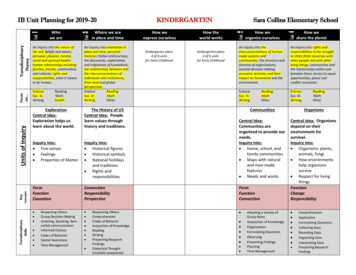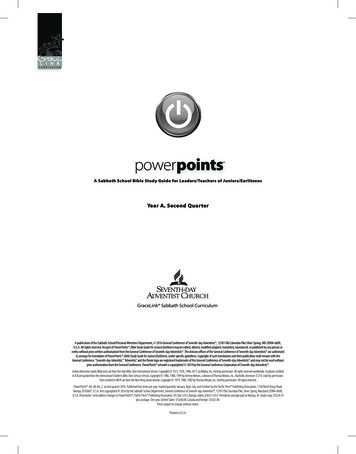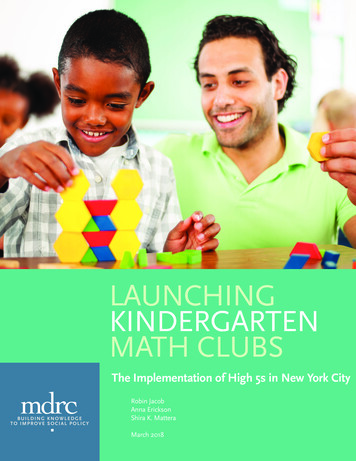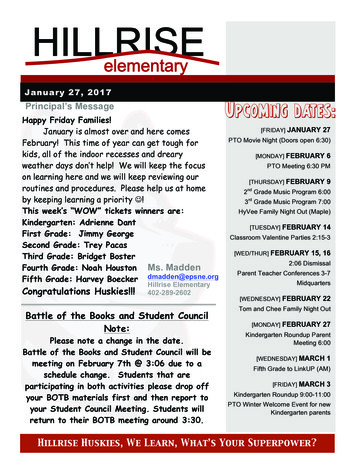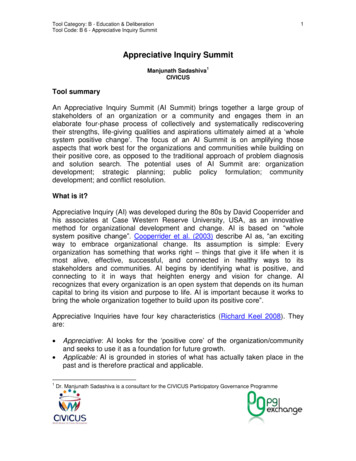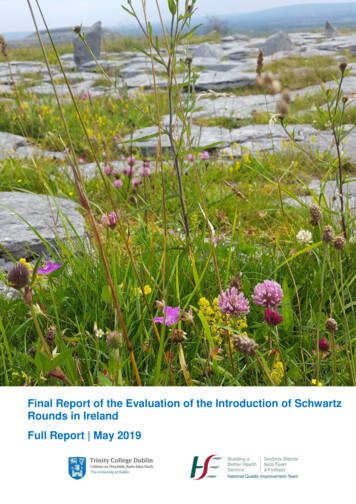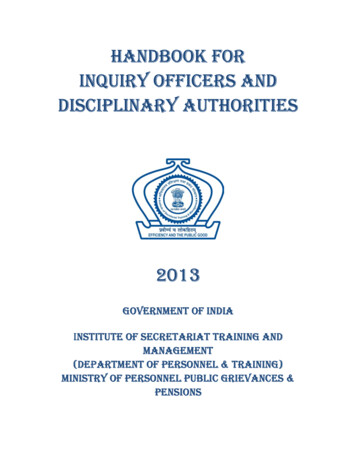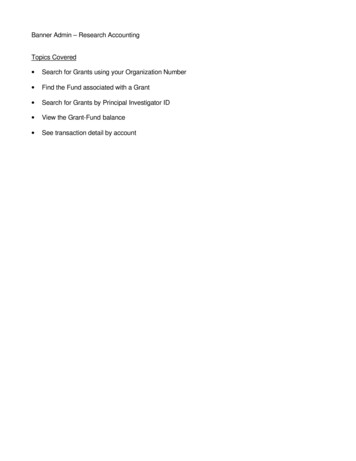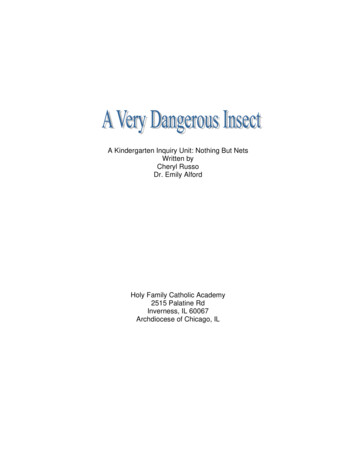
Transcription
A Kindergarten Inquiry Unit: Nothing But NetsWritten byCheryl RussoDr. Emily AlfordHoly Family Catholic Academy2515 Palatine RdInverness, IL 60067Archdiocese of Chicago, IL
Unit Overview: description of kindergarten challengeKindergarten students will receive a special letter from the NothingButNets andthe U.N. Foundation asking them to help tell people about malaria and how toend this terrible disease. Attached is a curriculum plan for an inquiry mini-unitthat focuses on insect characteristics, how those characteristics help animalssurvive, and ways in which people can be protected from some harmful animalslike the mosquito. The lessons are designed to stand alone or to enhance aprimary unit on insects, usually taught across the United States in kindergarten orfirst grades (1, 2).The attached curriculum meets the content established by Illinois State Goal 12;Know and apply concepts that explain how living things function, adapt andchange, and Illinois State Goal 17, Understand world geography (2). Thecurriculum is color coded, linking standards and benchmarks to teachingactivities. These materials include activities that engage the students as well asprovide other resources (or links to specific websites) necessary to complete theunit.The mini-unit culminates with students working in teams to create a mural andparticipate in a skit depicting the characteristics of insects, including mosquitoesand the impact mosquitoes have on people. The imaginary trip to Africaintroduces students to the long distances between continents.(1) All references are made to Illinois State Goals and Standards. Pleaserefer to your specific state’s goals and standards for reference.(2) The curriculum also meets the content established by the Office ofCatholic Schools, Archdiocese of Chicago Curriculum Framework.Holy Family Catholic Academy2515 Palatine Rd.Inverness, Illinois 60067
Dangerous Insect Inquiry Learning Mini-UnitKindergarten CurriculumIndexDescription of Kindergarten ChallengeDividers to Separate Unit ComponentsLetter to Students from NothingButNets and the UN FoundationInquiry-Based Learning Unit OverviewLesson PlansNon-Fiction Reading Resources:Mystery Insects (pictures)Animal Features (book) by Dr. Emily AlfordInsects: Friend or Foe (book) by Dr. Emily AlfordAfrica (article)Mosquito Fact Sheet (article)Insect Note-Taking FormatImaginary Trip to Africa (script)
Dear Students,(Read this section on day one)Help! Help! There is a dangerous animal that is hurtingpeople. It flies. It buzzes. It bites people and makesthem sick.What is this dangerous animal? Can you guess? Is it abear? A lion? What does it look like? What if I told youthat the animal is very, very small? Can you guess thename of a very, very small animal that can hurt people?The animal is a certain kind of mosquito that causes adisease called malaria. You know about colds and chickenpox and the flu, but do you know about malaria?On the continent of Africa (find on globe) the littlemosquito is biting people and making them sick withmalaria. But you can save the people in Africa from gettingsick and dying. How can you do this? You can help bylearning about the mosquito and malaria as you study aboutother insects that live on Planet Earth.(Read this section on day six)People in Africa need your help. Nowyou will learn about Africa. Drawpictures showing an African child. Thenshow how Mosquito nets can save livesby protecting people from gettingbitten.We want people to make donations toNothing But Nets so the United NationsFoundation can fund nets for children being infected withmalaria. Your mural can tell about mosquitoes and bed nets.We hope your mural will make people want to donate money tobuy more and more nets. For each 10 received, a net canbe purchased.
Lesson PlansDay OneSTATE GOAL 12: Understand the fundamental concepts, principles andinterconnections of the life, physical and earth/space sciences.A. Know and apply concepts that explain how living things function, adapt andchange.B. Know and apply concepts that describe how living things interact with each otherand with their environment. Identify and compare the characteristics of insects during each stage ofdevelopment.Opening Activities: Day 1: engage the children through the opening activities by having them identifymystery insects (insect pictures can be found at Enchanted Learning; fly, ladybug,cricket, butterfly, honeybee, dragonfly OR in Resource section of this unit).Students work in teams to match the insects with their names and discuss whatthey know about each one. Post pictures of each insect (excluding mosquito), along with their name, and askstudents to tell one or two things that they know about the animal. Then, post themosquito picture and ask what they know about this insect. Students define task and ask questions about insects (K/W) using the UnitedNations letter as a springboard for inquiry (send home the letter to informparents). Post chart paper and follow the model below:What are we being askedto do? save the people inAfrica from gettingsick and dying by learning about themosquito and malariaas we study aboutother insects that liveon Planet Earth.What questions do we havenow?Will this mosquito hurt us?What is malaria?Why do people get malaria?Where is Africa?How can we help savelives?What are nets?
Lesson PlansDay Two and ThreeSTATE GOAL 12: Understand the fundamental concepts, principles andinterconnections of the life, physical and earth/space sciences.C. Know and apply concepts that explain how living things function, adapt andchange.D. Know and apply concepts that describe how living things interact with each otherand with their environment. Identify and compare the characteristics of insects.Inquiry begins with students learning about animal features. Locate the mosquito and insect books found in the Resource section of thisdocument and make multiple copies. Inquiry begins with students seekinginformation from on-line and other resources comparing insects and the mosquito.One book compares several insects to the mosquito and shows the basiccharacteristics of insects, the other book describes helpful insects. Students workin pairs and take a picture walk through the books then share what they learned. Write the word ‘features’ on chart paper. Hold up your hand as an example of afeature and ask, “What is this part of my body called?” Write the word ‘hand’ onchart paper under the label ‘features’. REPEAT WITH SEVERAL OTHERBODY FEATURES ENDING WITH EYES. Working in pairs, students examine each other eyes. Have them describe whatthey see (lashes, pupils, colored parts, white parts, etc. Use magnifying glass ifavailable.) They draw a picture of their partner’s eye. Write the word ‘eye’ onthe chart paper. Repeat with other body parts, including feet. Give pairs of students the online book, Insect Features. Have them read the bookusing words and pictures. Meet with students in their guided reading groups andsummarize what they have learned about mosquitoes using the Fact Sheet fromthe website as a guide. From the summary of facts, students complete the notetaking form, downloaded from the website.
Lesson PlansDay Four and FiveSTATE GOAL 12: Understand the fundamental concepts, principles andinterconnections of the life, physical and earth/space sciences.E. Know and apply concepts that explain how living things function, adapt andchange.F. Know and apply concepts that describe how living things interact with each otherand with their environment. Identify and compare the characteristics of insects.Lesson description: Compare the mosquito’s eye to that of a human Remind children of the way their own eye is shaped. Have them re-examine eachother’s eyes in pairs. Hand out the worksheet showing the mosquito eye(http://biotech.arl.arizona.edu/images/T092.jpg ). Students draw a human eye onthe worksheet. Compare the human eye to that of a mosquito. Repeat, focusingon the human nose and the mosquito’s proboscis. STUDENTS DO “INSECT’S BODY” SONG ON DR. JEAN CD: KISS YOURBRAIN (#16). (CD or individual song may be ordered from the followingwebsite: http://drjean.org/html/cds f/cds kiss.html ) Children work in pairs to name the parts of a mosquito (using online bookresource). Then students draw pictures of mosquitoes. The mosquito picturesshould have three body parts that are characteristic of insects. Students draw a picture of a mosquito for the bulletin board display.
Lesson PlanDay Six and SevenSTATE GOAL 12: Understand the fundamental concepts, principles andinterconnections of the life, physical and earth/space sciences.G. Know and apply concepts that explain how living things function, adapt andchange.H. Know and apply concepts that describe how living things interact with each otherand with their environment. Identify and compare the characteristics of insects.Lesson description: Take an imaginary trip to Africa in order to give studentsbackground information and to help them understand the length of time it would taketo visit this continentent. Re-read the NothingButNets and U.N. Foundation letter, focus on part two,and add to task analysis from Lesson One.Imaginary Trip to Africa:1. Using a world map and globe, locate and label North America, theAtlantic Ocean, and Africa. Have students label the two continents ofAfrica and North America.2. Show a passport, if available, and explain the purpose of having apassport. Download a passport from the website:www.abcteach.com/countries/passport.htm Have students write theirnames on the passport.3. Tell the students that you are taking a trip to Africa. LOCATEIMAGINARY FLIGHT TO AFRICA FROM RESOURCE SECTION OFTHIS UNIT.4. Every hour, mark the distance traveled on the map 5. Land in Casablanca and role-play what we see, hear, and how hot it is 6. Re-board the plane to fly to Kenya Download and print the book entitled, “Nets Are Nice” from the followingwebsite: rials.php Readthe book aloud, connecting what the book is telling to what students havelearned so far. Explain how bed nets are used to protect people from gettingbitten.Draw picture of an African child for the bulletin board. Post the pictures andas money is raised for Nets, PUT A SMALL PIECE OF NETTING OVERTHE PICTURE TO SHOW THAT THE CHILD HAS BEEN SAVED FROMMALARIA.NOTE: I CHOSE NOT TO MARK THE DISTANCE ON THE MAP FOR THEPRETEND TRIP TO AFRICA. I THINK THAT BY USING THE THREE MEALSAND TIME IN BETWEEN AND LANDING AT MIDNIGHT (CASABLANCA TIME)THE CHILDREN WILL GET THE IDEA THAT AFRICA AND THE MOSQUITOESARE VERY FAR AWAY FROM US
Lesson PlanDay EightFinal Activity: Mosquito SkitGirls dress in simple costumes to play the part of the female mosquitoes (only the femalebites). They wear black leotards and tights (if available) and wings (angel wings workwell). Antennas are pipe cleaners attached to a plastic headband. A 9x12 paper is rolledinto a cone shape and taped for the proboscis. It is attached to the girl’s face by an elasticmask string. Boys wear regular school clothesMOSQUITO SKITBoys are spaced on stage so that girls may weave in and around them easily.Girls fly around boys and bite them with their ‘proboscis’.One or two children enter the area and ask, “What’s going on here?”Girls stop and say (in a high pitched voice); “We’re mosquitoes and we’re biting peopleto get blood for our food.”Girls continue to go around biting each boy. After they are bitten, the boys dramaticallysay, “I don’t feel well. That mosquito made me sick.” They slowly drop to the floor.Girls come together in a semi-circle and say, “Sorry, we forgot to tell you, we carry adisease called malaria.”
Mystery Insects (pictures)Animal Features (book)Insects: Friend or Foe (book)Africa (article)Mosquito Fact Sheet (article)Insect Note-Taking FormatImaginary Trip to Africa (script)Map of AfricaPictures of Insects and Their Features
Mystery Insects
"Photo courtesy PDPhoto.org"
AfricaAfrica is a very big and special continent on the earth. If youwould fly on an airplane from the United States to Africa youwould have to cross the Atlantic Ocean. It will take you all day toget there. If you leave at breakfast you will get to Africa atbedtime.When you get to Africa will see many kinds ofcover much of Africa. There are very hot anddeserts. There are wet and rainy areas calledthe equator. The equator is the imaginary linethe middle of Africa.lands. Grasslandsdry lands calledrain forests nearthat runs throughYou will see many people in Africa. There are about 911 millionpeople that live in 54 countries in Africa. You will hear the Africanpeople speak about 2,000 languages.You will see many big things in Africa. The continent of Africa hasthe biggest desert in the world. It is called the Sahara Desert.Africa has the biggest river in the world. It is the Nile River.Africa has the biggest mammal on earth. It is the elephant.Africa has the tallest animal on earth. It is the giraffe. Africahas a very big mountain called Mount Kilimanjaro in the country ofTanzania.Africa is a continent with many countries, people, languages,animals and big things to see.
NameMosquitoesheadthoraxabdomen1.Mosquitoes are insects.2.Mosquitoes buzz.3.Mosquitoes live near water.4.Mosquitoes have six legs.5.Mosquitoes have two wings.6.Mosquitoes have two antennas.7.Mosquitoes have three body parts.8.Mosquitoes have a head, a thorax and anabdomen.9.Mosquitoes have a proboscis.10. Mosquitoes drink plant juices.wingleg
11. Female mosquitoes suck blood from animalsand people.12. The Anopheles mosquitoes may bite people andmake them sick. They can give people malaria.
Name:My notes on mosquitoes:1. color2. number of legs3. number of body parts4. food it eats5. where it livesHelpfulHarmful
Imaginary Flight to AfricaPreparation: Arrange student chairs in a hallway to resemble the seating of anairplane. Place an adult chair in front of the chairs for the pilot. Download passport www.abcteach.com/countries/passport.htm Make, “Welcome to Casablanca” and “Welcome to Nairobi” postersProcedure:Early in the school day tell the children that they will be taking a pretendtrip to a far away continent called Africa. It is a huge continent with manyanimals and people who speak different languages. How lucky they are to begoing to such a wonderful and exciting place! Locate Africa on a map orglobe. Before they leave their country they will need a special little bookcalled a passport to be able to “get into” Africa. At this point have thechildren write their names on the prepared passport, pack their pretendluggage and walk to the airplane.Students take their seats and the flight attendant (teacher) asks them toput on their pretend seat belts and to put all of their bags under their seats.Then the captain (teacher) takes a pretend microphone and welcomes thepassengers aboard. He/she tells the passengers that the plane is leavingNew York City and will be flying across the big Atlantic Ocean to thecontinent of Africa. It will take 10 hours to get to a city called Casablanca.Passengers are invited to relax and enjoy the long flight.To help the students understand the great distance between the twocontinents the teacher will serve three meals on the plane with some “downtime” in between. The captain tells the students it is now 9 AM and theflight attendant will be serving breakfast. Pass out the pretend trays offood, allow students time to eat and collect the trays. The captain invitesthe students to look out and see the clouds and the blue water of theAtlantic Ocean. Teacher then reads a short story to students to “pass thetime”. Repeat this procedure for lunch and dinner.The captain then says that we have been on the airplane for ten hours.Flight attendants need to “prepare for arrival”. Seat belts are fastened andthe pretend plane lands in Casablanca Morocco. The captain tells passengersthat the local time is twelve o’clock (midnight) and that the temperature is70 degrees. Students leave the plane and have their passports stamped
before entering the classroom. Upon entering the classroom there will be asign saying “Welcome to Casablana”. Children are then invited to rest (as it ismidnight). Teacher can then read a story such as Welcome to Morocco byDeborah Fordyce. At this point conclude this part of journey.Either later in the day or the next day, announce to the children that theyare going to have the opportunity to fly to another wonderful country inAfrica called Kenya. (Locate Kenya on the map or globe). They are going tofly all away across the continent of Africa to get to Kenya. What do theythink they will see? Write the responses on chart paper. Children will thenshow their passports as they board the pretend airplane. Seat belts areagain fastened and the captain welcomes them on board. It will be a fourhour flight to Jomo Kenyatta International Airport in Nairobi Kenya. Apretend meal is served. Teacher then reads the Africa Fact sheet that wasdownloaded from the website as the plane flies over the various landformsabove the continent of Africa. Another meal is served. Captain tells flightattendant to prepare for landing. Local time is 7 hours from New York.Temperature is 70 degrees (F). Instruct the students to look down and seethe big game camp of animals before landing in the city of Nairobi. It looksalmost like the zoo at home! Children leave the plane and have theirpassports stamped to enter the country of Kenya. They enter theirclassroom and see a sign“Welcome to Nairobi”. At the airport the peoplethey see have black skin and are speaking many different languages. Thereare many men at the airport, but not many women. They are wearing brightlycolored robes and have come from many different countries in Africa.Leaving the airport the children see the big city of Nairobi. It is a dusty cityand they see people walking to work wearing flip flops and light coloredclothing. Everyone has black skin. The women are wearing long skirts andblouses and the men are wearing pants and short sleeved shirts. Next thestudents are going to get into a jeep and drive for four hours along a dustyroad into the “bush”. It is the rainy season (April) and the grass is long andgreen and there are many Acacia trees. The jeep passes little homes calledhuts that are made out of cow dung, sticks and grass. There is a smallopening to enter the hut, but no doors or windows. The people have veryblack skin and are smiling and waving at us. They are wearing colorful robesof blue and red. They are also wearing colorful beads. Everyone is happy thatit is raining to help the plants and animals, but they are sad because it meansthat they are many mosquitoes. The people know that some mosquitoes in
Africa carry a disease called malaria. They do not want the mosquitoes tobite them and make them sick.What could be done to help these African people? Take responses fromchildren.Wouldn’t it be wonderful if we could buy nets for the people to sleep underto keep the mosquitoes away? How much do they cost? How could they raisethis money?Say good-bye to the people of Africa and promise them that we will helpsave them from the mosquitoes by buying nets for them.
Lesson Plans Day One STATE GOAL 12: Understand the fundamental concepts, principles and interconnections of the life, physical and earth/space sciences. A. Know and apply concepts that explain how living things function, adapt and change. B. Know and apply concepts that describe how living things interact wit

